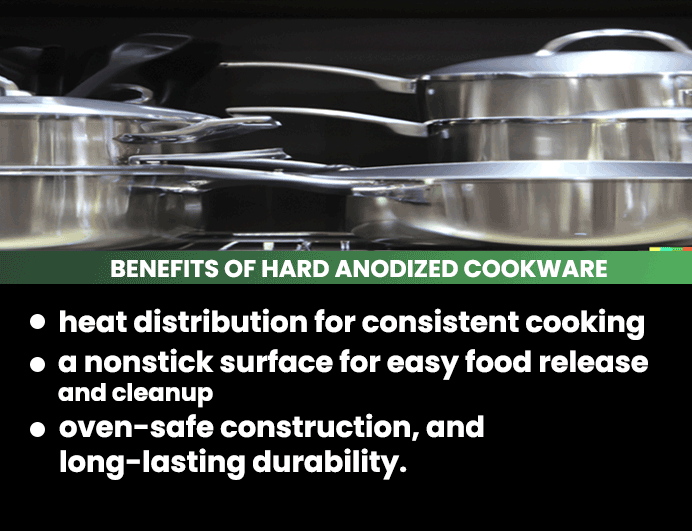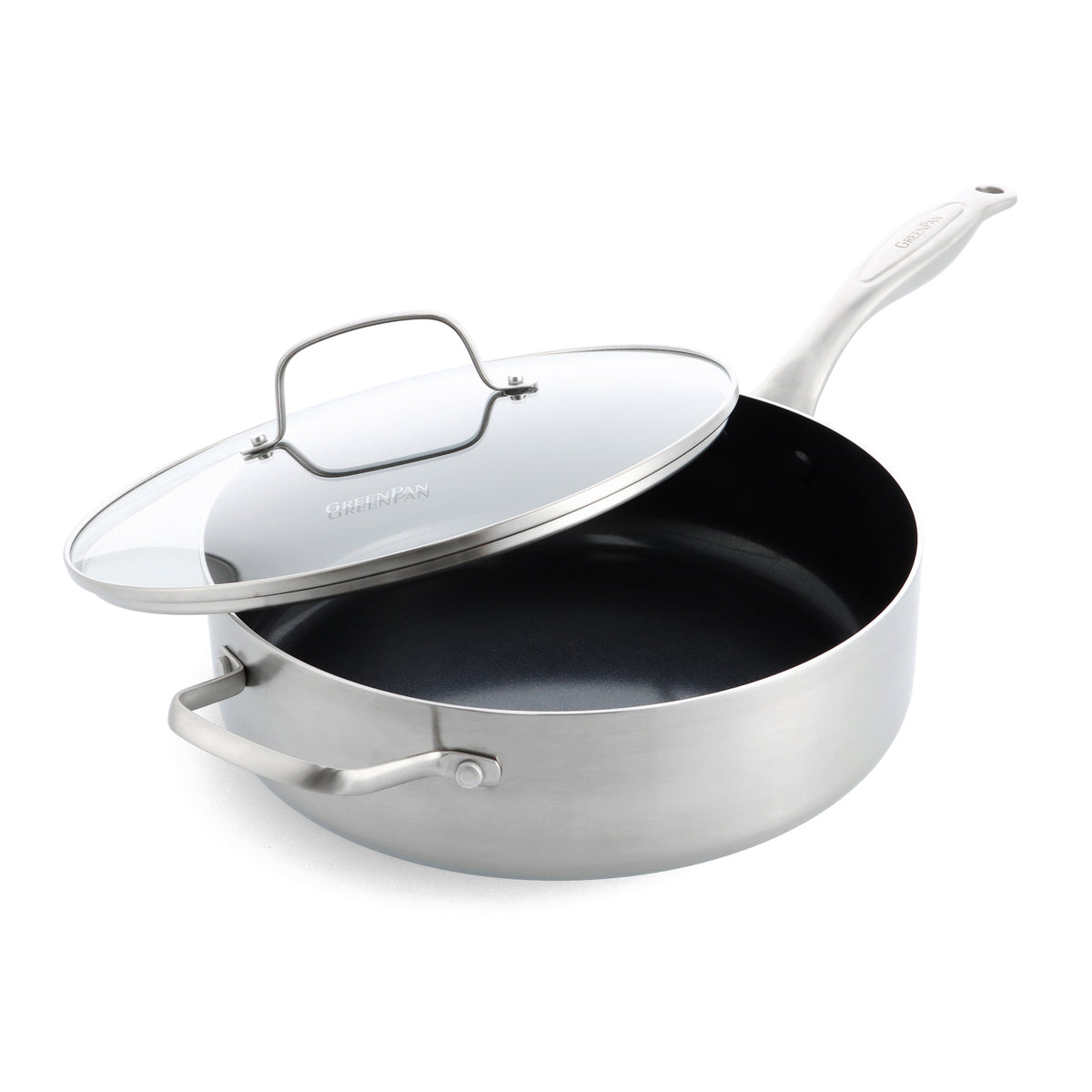As an Amazon Associate, I earn from qualifying purchases
The drawbacks of anodized cookware include a lack of non-stick properties compared to coated non-stick pans and the need for regular maintenance to maintain its non-stick properties. Anodized cookware is durable but can scratch with the use of sharp metal utensils, and it is often heavier than other types of cookware.
However, anodized aluminum is generally considered safe for cooking as it is sealed and does not interact with acid like regular aluminum does. Anodized cookware is a popular choice for many home cooks due to its durability and ability to withstand high cooking temperatures.
However, like any other type of cookware, it has its drawbacks. We will explore the disadvantages of using anodized cookware, such as its lack of non-stick properties compared to coated non-stick pans and the need for regular maintenance to preserve its non-stick properties. We will also discuss other considerations, such as the potential for scratching with sharp metal utensils and the weight of anodized cookware. Despite these drawbacks, anodized aluminum is generally considered safe for cooking.

Credit: www.amazon.com
Table of Contents
ToggleDrawbacks Of Anodized Cookware
Despite its numerous advantages, anodized cookware does have some drawbacks that are worth considering. In this section, we will explore the limitations of anodized cookware and why it may not be the ideal choice for everyone.
Lack Of Non-stick Properties
One of the main drawbacks of anodized cookware is its lack of non-stick properties. While hard anodized surfaces are naturally stick-resistant, they don’t offer the same level of non-stick properties as coated non-stick pans. This means that you may need to use oil, butter, or other cooking fats to prevent your food from sticking to the surface. Unlike non-stick pans, anodized cookware requires a bit more effort to ensure that your dishes don’t cling to the surface.
Maintenance
Another drawback of anodized cookware is its maintenance requirements. Although anodized cookware is known for its durability, it still requires some care to maintain its non-stick properties over time. Improper cleaning or the use of harsh cleaning agents can damage the anodized surface and reduce its non-stick capabilities. Additionally, anodized cookware may not be dishwasher safe and may need to be hand washed, adding to the maintenance efforts required.
Durability
While anodized cookware is generally durable, it is not completely scratch-resistant. Sharp-edged metal utensils can potentially scratch the anodized surface, compromising its longevity. It is important to use wooden or silicone utensils to prevent any accidental damage to the cookware. Additionally, anodized cookware tends to be heavier compared to other types of cookware, which can make handling and maneuvering in the kitchen a bit more challenging.
In conclusion, anodized cookware has its drawbacks, including its lack of non-stick properties, maintenance requirements, and potential for scratching. However, with proper care and consideration, anodized cookware can still be a reliable and long-lasting option for your cooking needs.
Health Concerns
Anodized cookware can be less non-stick and prone to scratching with metal utensils. Regular maintenance is needed to preserve its non-stick properties. Despite these drawbacks, anodized aluminum is generally recognized as safe for cooking.
Safety Of Anodized Aluminum
One of the main health concerns associated with anodized cookware is the safety of the aluminum used in its construction. While there are concerns about cooking with regular aluminum due to its potential interaction with acidic or alkaline foods, anodized aluminum is generally considered safe. The anodization process creates a protective layer on the surface of the cookware, preventing direct contact between the aluminum and the food. This layer helps to minimize the leaching of aluminum into the food, making anodized aluminum a safer alternative.
Use Of Cooking Fats
In order to maintain the non-stick properties of anodized cookware, it is often necessary to use cooking fats such as oil, butter, or another type of cooking fat. While this may not be a concern for some individuals, it can be a drawback for those who are trying to reduce their fat intake or follow a specific dietary plan. The use of cooking fats can add extra calories and fat to the cooked food, which may not be desirable for health-conscious individuals. Additionally, using cooking fats can increase the risk of consuming unhealthy trans fats if the wrong types of fats are used.
Furthermore, the reliance on cooking fats can limit the versatility of anodized cookware. Some cooking techniques, such as dry sautéing or stir-frying without added fats, may not be as effective with anodized cookware. This limitation may be a factor to consider for those who rely on these cooking techniques to prepare healthier meals.
Maintenance Of Anodized Cookware
While anodized cookware is known for its durability, it still requires proper care to maintain its non-stick properties over time. Failure to maintain the cookware can lead to decreased effectiveness and potential health concerns. Here are a few maintenance considerations:
- Proper Cleaning: Harsh abrasives and scrubbing pads should be avoided as they can damage the anodized surface. Instead, gentle cleaning with mild dish soap and a soft sponge or cloth is recommended.
- Avoiding High Heat: Anodized cookware should not be subjected to extremely high temperatures, as this can cause the non-stick surface to degrade. Using the cookware within its recommended temperature range is essential for preserving its integrity.
- Avoid Metal Utensils: Using sharp-edged metal utensils can scratch the anodized surface, compromising its non-stick properties. Opting for non-metal utensils, such as silicone or wooden utensils, can help to prolong the lifespan of the cookware.
- Avoid Storing with Other Cookware: Stacking anodized cookware with other pots and pans can cause scratching and damage to the non-stick surface. Storing the cookware separately or using protective padding between the stacked items is advised.
By following these maintenance practices, you can ensure that your anodized cookware remains in good condition and minimizes any potential health risks associated with its usage.
Comparison With Other Cookware
When considering cookware options, it’s important to weigh the drawbacks. Anodized cookware, while known for its durability and even heating, has its limitations compared to other types of cookware. Let’s explore the drawbacks of anodized cookware in comparison to non-stick and stainless steel cookware.
Comparison With Non-stick Cookware
Non-stick cookware is popular for its easy food release and effortless cleaning. In contrast, anodized cookware, while somewhat stick-resistant, does not provide the same level of non-stick properties as coated non-stick pans. This may lead to food sticking to the surface, especially over time, necessitating the use of oil or fats for cooking and maintenance. Additionally, anodized cookware can be prone to scratching if harsh utensils are used, unlike most non-stick cookware which is more forgiving in this regard.
Comparison With Stainless Steel Cookware
Stainless steel cookware is valued for its longevity and elegant appearance. However, when compared to anodized cookware, it may be less efficient in heat distribution and retention. Anodized cookware, on the other hand, excels in heat conductivity and even cooking. Nevertheless, stainless steel offers better non-stick properties than anodized cookware. Furthermore, stainless steel is often lighter and easier to maintain, while anodized cookware may require more careful handling to preserve its non-stick surface over time.

Credit: medium.com
Expert Opinions
When considering anodized cookware, it’s important to note the lack of non-stick properties compared to coated non-stick pans. Additionally, maintenance is necessary to uphold the non-stick properties over time, as the cookware can scratch with the use of sharp-edged metal utensils.
Overall, it is a durable option but may require more care.
Professional Chefs’ Views
Professional chefs often note that anodized cookware lacks the optimal non-stick properties they require for precise cooking techniques.
Cookware Experts’ Perspectives
Cookware experts emphasize the importance of maintenance with anodized cookware due to its susceptibility to scratches from sharp utensils.

Credit: www.greenpan.us
Frequently Asked Questions For What Are The Drawbacks Of Anodized Cookware
Which One Is Better Hard Anodized Or Nonstick?
Hard anodized cookware is durable, but lacks the same non-stick properties as coated non-stick pans. It requires maintenance to maintain its non-stick properties. Hard anodized pans may scratch if used with sharp-edged metal utensils and are often heavier than other types of cookware.
However, anodized aluminum is generally considered safe for health.
What Is The Disadvantage Of Anodised Cookware?
The disadvantages of anodized cookware include: 1. Lack of non-stick properties compared to coated non-stick pans. 2. Requires maintenance to maintain non-stick properties over time. 3. Can scratch if sharp-edged metal utensils are used. 4. Cookware is often heavier than other types.
5. May require the use of oil or cooking fat to prevent food from sticking.
Is Anodized Cookware Safe For Health?
Anodized cookware is generally considered safe for health because the anodization process seals the aluminum, preventing interaction with food and acidic substances. However, be mindful of using sharp utensils as it can scratch the surface and require some care to maintain its non-stick properties over time.
Is Hard Anodized Cookware Good Or Bad?
Hard anodized cookware is good due to durability, scratch resistance, and heat tolerance.
Conclusion
While hard-anodized cookware offers many benefits such as durability and heat resistance, it also comes with some drawbacks. These include lack of non-stick properties and the need for maintenance to preserve its non-stick features. Additionally, it can be prone to scratching when used with sharp utensils.
Despite these drawbacks, hard-anodized cookware remains a popular and valuable choice for many kitchens.
As an Amazon Associate, I earn from qualifying purchases

